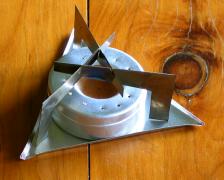 It boils water in a reasonable time as a result. The stove weighs only 22 g, while the cooking foil windscreen supplied with it weighs 15 g.
It boils water in a reasonable time as a result. The stove weighs only 22 g, while the cooking foil windscreen supplied with it weighs 15 g.Send any comments to the maintainer Roger Caffin
Given the joys of an inventive capitalist society, we have a whole range of stoves, brands and fuels to choose from. Equally, each stove has its devoted followers. It follows therefore that the majority of walkers will disagree with what is recommended here: whatever I recommend, it's wrong! Never mind. We start with a bit about buying a stove - which is difficult given the range of choices. Then we list most of the fuels which can be used, with pros and cons. Mention of a brand anywhere does not imply any endorsement. Finally we go over stove use and tricks of the trade for best results. (The author admits to having too many stoves in the cupboard, partly as a result of dissatisfaction with so many of them, but also because the companies keep sending them to me to review.)
Many of you might just want to know which stove to buy. There is no really simple answer, but the author admits to a very strong bias towards modern screw-thread gas stoves after much field experience plus doing several extensive field trials for reviews and studies of stoves, but others will disagree.
| Contents | ||
|---|---|---|
|
Stoves (this page)
|
(subsequent pages)
Fuel Efficiencies - technical details Butane/Propane mixtures - technical details |
In choosing a stove it pays to consider just what you are normally going to be doing with it. For instance, if all you will ever do is make a cup of tea while everyone else catches up and has a long rest, speed of boiling might not matter. If you belong to the American 'boil water and make mashed potato' school of cooking, most anything might do. On the other hand, if you want to cook decent meals for two people, you would be well advised to go for a stove with an adequate fuel capacity and the ability to simmer well. We will start with the more basic stove matters, and later on we get a bit more detailed and also list a whole lot of tricks for good stove use.
Stove manufacturers boast about their fast boil times, but in truth comparing "3 minutes 30 seconds" with "3 minutes 45 seconds" is pointless. There are lots of external factors which can change these times, and anyhow you rarely want the stove going full roar. Doing so is extremely wasteful of fuel, and that's weight you have to carry. The advtisements rarely tell you this: it isn't macho. Far more important is whether you can turn the stove down to a gentle simmer so you don't burn the stew. They rarely tell you about this either - maybe because few stoves can be throttled down. But a stove on simmer is very cheap to run - and makes a nice background sound late in the evening in your tent. To us, that sound means food is coming.
None of the stove ads mention how long it takes to set the stove up, nor how long it takes to light the stove. Liquid fuel stoves (petrol and kero) generally require you to fill the tank, then pump up the pressure inside to drive the liquid, then make sure the jet is clean, then do a bit of priming, then pump some more, then warm the stove up ... This takes quite a bit of time and fuel, but fortunately you don't have to do all of it every time. Other stoves usually are much easier to light. Lighting a petrol stove is usually fairly simple (unless it is sub-zero), needing no priming apart from a slight leak of petrol and a match. The disadvantage of a petrol stove is that petrol is extremely dangerous, especially when that leak is too large, and people do have accidents with it. (The author is now very wary of petrol, having lived through too many "happenings".) Kero stoves require complex priming which takes a few minutes. On the other hand, it is a very safe fuel - but it smells. With a gas stove you screw the burner onto the cartridge, turn the valve and flick a lighter. No smell either. If you have a piezo-ignitor, well, too simple!
It is understandable that a small special-purpose stove made in limited quantity will cost a bit. However, I have never understood just why some bushwalking stoves are so incredibly expensive. We'll cover costs elsewhere in more detail, but a basic gas stove costs about $40. If you want to spend upwards of $200 on a stove, so be it. These days you should also consider buying over the web instead of from a city gear shop: sometimes it can be cheaper.
You usually want to be able to turn a stove down once your dinner is (near) boiling, to let it simmer. Here we have a problem. Most liquid fuel stoves with a single valve on the liquid are, basically, a pig to control. The very fine valve clearance needed to control the liquid flow is not stable. Sure, the stoves function like a flame thrower, but many of them are notorious for having no ability to simmer. Some liquid fuel stoves have two valves: a shut-off valve on the tank and a gas flow valve near the burner. These work much better, but can be more complex. Metho stoves have little control anyhow, while gas stoves in general have superb control over a wide range. Solid fuel? Throw another tablet on the fire or blow it out ... So choosing a stove is not that simple.
Let's introduce a critical technical point right here: flame speed. Some fuels burn with a very high flame speed (think of an oxy-acetylene torch), while other burn with a very slow flame speed (think of a candle). How fast the flame goes matters quite a lot when there is wind around. If the flame is slow it can be blown a long way sideways, even to the point of missing the cooking pot entirely. So different fuels and stoves are going to be affected by wind to different degrees. The normal way to handle this is a windshield: we will come back to this later. Suffice it for now to note the problem.
Most of our gear is fairly harmless, but stoves are not. You can be playing around with a quantity of highly volatile, even explosive, fuel. The potential for disaster does not end there: people have been harmed and even died in snow caves and tents from the fuel fumes, lack of oxygen or excess carbon dioxide, and more insidiously from carbon monoxide. But most users manage to handle all this with complete safety, just by following some simple safety precautions. These are covered in the safety section. Read it!
A major factor in choosing a stove is the total weight you will be carrying. Let it be admitted right now that a wood fire requires little more than a box of matches - and some bags to put the very dirty cooking pots in. Any stove you choose will add weight. But there is more to it than just the weight of the stove: you have to consider the weight of the stove plus the weight of the fuel for the trip you are doing. This brings in the efficiency of the fuel, the ease of lighting, and even how you go about refuelling on a long trip. To keep this page from getting too long, this whole area of efficiency has been moved to it's own Fuel Efficiency page. And of course, once you have a stove you don't have to stand out there in the pouring rain (howling wind) trying to cook over a fire which keeps going out. Instead you can be safely ensconced in your sleeping bag in your tent, feeling terribly smug about the comforts of life.
It's a bit hard to talk in general terms about stoves for all fuels, so we will focus on the more common bushwalking stoves: petrol, kero and gas, but we will also mention metho, solid fuel and even wood. Before we go any farther down this track, I should refer interested readers to the massive Stoves web site run by Zen Seeker. This covers stoves of all types and fuels in all their glory in far greater detail than I have here. In addition, there are several stove collector web sites of great fascination, including one on 'classic stoves' (mainly kero and petrol) and one in Japan run by 'Super Shioshio' and solely dedicated to gas stoves. You think I am a bit keen? You haven't seen these guys!
It is possible to lump most stoves, especially those burning petrol, kero and gas, into two general classes: those with an integral tank and those with a hose to a remote tank. Does it matter, and is there any real difference? There are indeed several differences. The first is one of mechanical stability, although some will argue about this. When the stove burner is detached and low to the ground it is usually more stable - especially with a large pot of stew being stirred on top. When the fuel tank is attached underneath the stew is way up in the air. However, some argue that the large fuel tank at the bottom makes a more stable base. It depends: I use both.
Another difference is how close the fuel is to the heat. This can matter! One time we had an integral tank petrol stove (Optimus 8R) on Goon Moor in SW Tassie and we were cooking a lot of pancakes on it with a large frying pan. The weather outside was 'poor', even for that place. We were inside the tent, and after the N'th pancake (N being a large number) the tank got too hot. Heat reflection off the large frying pan was most the likely cause. Anyhow, the safety valve on the petrol tank released the excess pressure. A fine idea, except that the petrol vapour coming out of the vent was aimed at the operator's arm and quickly lit. A long flame resulted, inside the tent. The stove went flying out through the (fortunately open) door into the rain and wet bog outside without igniting the tent. Not funny at all, really. On a couple of occasions in the more recent past I have suddenly realised that my gas stove was getting just a bit too excited: again radiation was hitting the attached tank, which had reached 'very hot'. I now use a radiation shield on it: this is described later. The moral is to be careful.
On the other hand, warming up the fuel tank just a little bit can help the stove run. This applies especially to gas cartridges containing the butane/propane mix, so often a thermal balance is required. Even some of the experimental metho stoves (or Pepsi can stoves) have been known to get a bit excited, according to their inventors.
Most mainline commercial stoves have support arms to hold the pot. These can be round wire or flat sheet metal. A boiling pot vibrates, and can vibrate right off a smooth round wire support: I have seen it happen. The owner was quite surprised, and had to wait a while for his cup of tea. When you select a stove look carefully at the supports: are they smooth? If they are you can roughen them up with a chisel or a hacksaw, just enough to stop the pot from doing an ice-skating act. However, some of the cottage-industry metho stoves do not have pot supports, so you get to create your own. I would recommend some caution here: experience is needed.
Some stoves come with a built-in internal reflector or 'radiation shield' between the flame and the fuel tank, while some of the smaller folding stoves don't. The folding stoves are small and light, but that radiation shield is really vital for safety. It is not what so many call it, a 'windshield'; it's a radiation shield. Both this and the previous point are covered again later.
For the rest, see under Gas Stoves, Safety and Tricks for many other small pointers. However, there is no quick answer to the question of what's the best stove.

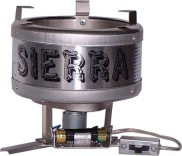
There are small "gipsy" stoves which use wood and paper as a solid fuel. They are seldom used in Australia, although such a kettle is available in a few shops now. I think we can put them in the 'tourist' category. Mind you, properly used they can heat water extremely fast! I found a reference to a commercial one called Thermette and made in NZ. It looks a bit like the one to the right.
The Zen Seeker's web site has pictures of several wood stoves, including some that use a battery-driven fan. The one to the left is the well-known (in USA) 'Sierra Stove'. Talk about a mix of technologies! One wonders what would happen in mid-summer when fueled with dry gum tree twigs: a towering inferno might be my guess. The idea works all right, but I question the safety in an Australian summer and the convenience in bad weather. I doubt its safety in a tent.
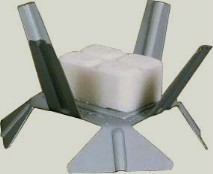
The fuel is a small solid block which can be lit with a match and was traditionally used by the Army. The original form (as far as I know) was created by the Esbit Compagnie GMBH of Hamburg, Germany. I have some from the 1950s, in the form of small pellets about 6 mm diameter. They were used to drive a little steam engine I had acquired in Germany when I was a kid. (It turned out that the steam engine had become a collector's item after all these years.) In their current form Esbit tablets are sold as small rectangular blocks each of about 14 grams, and often come with a little sheet metal 'stove' or base. An ultra-lightweight Esbit version is shown to the right. I think you would want to be a little careful what you put this down on.

Here in Australia we can buy genuine Esbit tablets, and also 'Fuel, Compressed Hexamine' made in Australia by ADI (Australian Defence Industries). They are normally used on a very cheap small fold-up metal burner which fits around the cardboard box of tablets. The tablets themselves are larger than the Esbit ones, at 45 x 45 x 10 mm and weighing 26 g each. Most bushwalking shops do sell kits of the burner and some fuel: the burner is shown to the left. There is only limited control over the amount of heat generated, but more heat can be had by adding another lump to the stove.
For more details on hexamine I will paraphrase from a review written by Edward Ripley-Duggan on the BackpackGearTest web site.
Esbit tablets are a solid fuel containing hexamethylenetetramine, also known as hexamine. The fuel is a white, waxy solid shaped into a small rectangular block. Esbit sell them blister-packed in thin clear plastic with a foil backing in strips of three in boxes of twelve tablets. They make the following claims, not all of which are entirly true:
* Practically odorless
* Non-toxic formula
* Emits no harmful vapors
* Leaves no ash residue [I disagree]
* Generates 760 degrees C
* 12-15 minutes burn time per cube
* One cube will bring 1 pint of water to a rolling boil in less than 8 minutes [maybe!]
However, despite the first two claims Edward points out that hexamine itself can emit a variety of harmful gases, including formaldehyde, hydrogen cyanide, ammonia and oxides of nitrogen on combustion, and repeated or prolonged contact can cause skin sensitization. That said, neither he nor anyone else I know has suffered any problems from Esbit tablets. I note my original Esbit tablets came wrapped up in a plastic bag: this may be a good idea. However, the ADI ones just came in a cardboard box with no bag.
My own experience with the ADI hexamine tablets is that about half a tablet is needed to boil two cups of water. This figures: they are about twice the size of an Esbit tablet. They leave a soft black charred lump when burnt out, and make a black tarry mess on the underside of your pot. For me, the slowness and mess make them relatively unattractive, but I am cooking meals for two.

In his review Edward said he had tried various forms of stove support for them with varying success, and found that a windshield was essential. This is because the flame velocity is very low so the flames can be blown sideways, as mentioned above. He had used them down to -18 C with some success, but would not recommend them for melting snow. Neither would I! He found that "two to three tablets are sufficient for one full day for one person (and this is very much a one-person method of preparing hot food). That's a maximum fuel weight of 43 g, though this is really a little on the high side, and assumes a hot breakfast drink, perhaps a hot lunch and a hot supper of freeze-dried food, far more than I can usually be bothered with)." If you use the BackPackingLight Ti stove shown here with the tablets, your stove is definitely minimalist and ultralight, but under benign conditions quite effective. The concept can be recommended to someone just starting out and wanting cups of tea, say.
There are other forms of solid fuel tablets, including trioxane. Edward writes that Esbit tablets are significantly less toxic and significantly more effective than trioxane, which is still used by the US Army in some situations. He adds that Esbit tablets may be easily blown out part-way through combustion, enabling fuel to be saved, while trioxane cannot be extinguished with any ease. I have seen hexamine on sale in bushwalking shops here in Australia, but not trioxane. My understanding is that some of these tablets are straight hexamine, while others may have paraffin wax blended in.
One could say that hexamine tablets are fairly safe if used in the open, can be stored for a long time if well sealed (some of mine are more than 30 years old), do not spill or go bang, and are quite hot. Certainly, the little Esbit tablets I have from 30 years ago still work just fine.
In fact, solid fuel does work, it is very light and very cheap, albeit wind sensitive and messy, and it is ideal for a novice walker who is not sure about spending any large amount of money on gear. It is also fairly suitable for recommending to or even issuing to a group of kids: they can't do (too) much harm with it (if supervised), and the little kit referred to above won't cost their parents much. One caution: they should all be used on a very non-flammable base!
Do-it-yourself versions are described on the web as well, including one which is supposed to burn wood, alcohol and solid fuel tablets. There is an excellent detailed write-up on hexamine, trioxane and other forms of solid fuel on the Zen Seeker's web page on Solid Fuel Burners. It contains far more technical information on these fuels than we have here, including their chemical formulae.
Jean Lawlor from America contributed some information about her use of solid fuels. I summarise:
If you can light the little hexamine fuel tablet, it will burn hot and furiously for about 5 - 7 minutes, just about long enough to bring about 8 oz (240 mL) water to boil, if adequately protected from wind. I used mine in a cheap mini folding sheet steel "stove" which provides good wind protection and a pot holder above the fuel. It does not readily light (good safety feature, but I don't know how you'd light it in high wind), but once lit it did not blow out in the wind, but the heating efficiency suffered. In fact, it probably would be difficult to extinguish the burning hexamine if you wanted to. More tablets burning simultaneously will, of course, provide more heat to boil a larger pot of water, or as the 1st tablet begins to burn out you can slip a 2nd tablet in next to it to continue the heat (easiest way to light a tablet). Sort of like repeatedly feeding wood into a campfire to keep it going, but cleaner burning--little odor or visible smoke. It leaves a black lumpy ash when consumed.
Personally, I carry older hexamine and newer trioxane with me for use as an emergency wood fire starter, a backup in case of stove failure, and for use in an emergency in the little sheet metal stove I carry in my car. I would not plan to use it for real cooking as I do on a backpack trip -- the heat supply isn't controllable (it's either full blast or not burning at all) or sustained enough to do more than boil a small cup of water or small pot of instant soup or noodles, which is what I've 'cooked' with it. Hexamine or trioxane with a little sheet metal stove might be a good choice for an ultralight 'fastpacker' or a short no-frills trip where you only want to quickly boil small amounts of water for instant coffee, soup, or tea, or to reheat pre-cooked food, e.g. military style MREs (meals-ready-to-eat).
There is only one widely available stove (in Australia) which uses this fuel: the Trangia. The stove has the advantage of stability and wind resistance, while the fuel is cheap and does not go bang. It is fairly widely available around the world. At least you should be able to identify it by smell. However, it is not light, control over the stove is poor by modern standards, it takes twice as long to boil some water and it uses twice the weight of fuel to do so (measured results). The problem is that the efficency of metho as a fuel is very poor: this may or may not worry you. Fuel availability in some countries is also poor. However, some owners seem to love them. Overseas it seems that Vaude also make a stove like the Trangia.
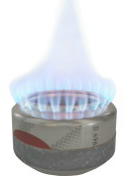
In addition, there is a whole world of alcohol-enthusiasts out there. Some of them are making variations on the Trangia. There are stoves made with galvanised downpipe and a Trangia burner, jellied alcohol packed in sardine tins, and a whole range of do-it-yourself stoves. My thanks to Breck Bowles for some of these references. Of course, when you finally tire of metho but still have your Trangia base, you can retro-fit a gas burner (from Trangia even) in it.
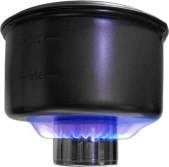
But that is nowhere near the end the metho saga. There is a vast community of 'Pepsi can Stove' fanatics in America. This stove is very similar to a Trangia burner but is made with great ingenuity out of several Pepsi cans, at least in principle. Very light and very cheap, and a typical model is illustrated to the left. Some versions are very simple and not much more effective than the Trangia, but some like the Zen Seeker's are quite sophisticated. There are top burners and side burners; there are open burners, open jet burners, and pressurised burners. They are (almost) all made from aluminium drink cans or aluminium pet food tins. The extreme version would have to be one made of titanium - and that too is now available! Some carry the dedication to the extent of using bigger aluminium drink cans (or 25 oz Fosters beer cans) as their cooking pots - but I suspect they only boil water for the 'mashed potato' style of meals.

To be fair, and to avoid being murdered by the hordes of metho-stove enthusiasts from America, it must be admitted that these little stoves do work, and some of them even work quite well. They have the advantage that for a night or two the combination of fuel and stove is extremely light, and they do not make a mess on the cooking pot. The one to the left is called a 'Sketti', and is a rather powerful semi-pressurised one by Mini Bull Designs, and it is able to support a pot and cook for two.
 It boils water in a reasonable time as a result. The stove weighs only 22 g, while the cooking foil windscreen supplied with it weighs 15 g.
It boils water in a reasonable time as a result. The stove weighs only 22 g, while the cooking foil windscreen supplied with it weighs 15 g.
The cute little stove to the right has got to be the ultimate in fragility, being made from a small soft aluminium pill case I think. But the legs are very thin sheet titanium, and will actually hold at least half a litre of water, maybe more! The entire stove and base plate and legs weigh 18 g, and the aluminium foil windscreen which came with it weighs only 12 g. This weight includes a base plate and something which I think is meant to be a 'simmer ring' as well! But it is very slow to get going, and very slow to heat anything more than a cup of water. In reality, that's all it is meant to heat.
Most of these little stoves have the disadvantage that the stove is not really controllable: it's either full power or off. And if your dinner isn't quite cooked when the stove goes out, you have to wait until the stove has cooled down before you can refuel it. I am assured by enthusiasts that they get to know just how much metho to put in each time. Just don't forget: they eat a lot of metho, as it isn't a very energy-efficient fuel.
Caution: bottles suitable for metho are not the same as bottles suitable for petrol or kero. Different plastics may be used. Well, that's what the labels on some Nalgene fuel bottles say, although many people have used PET bottle for kero and metho. (I have used them for kero.)

We lump unleaded petrol, Shellite and several other similar fuels (eg Coleman fuel, American 'white gas') all together. They are a volatile mix of hydrocarbons from the petroleum refineries. For the technically minded we point out that they are indeed mixtures, with some components more volatile than others. If you want more details, the Mixtures page may be of interest, even though it focuses mainly on gas mixtures. Anyhow, such fuels do not have a simple "boiling point": it changes as the boiling proceeds and the composition changes. One of the reasons for having a mixture is that the more volatile components help the stuff start burning. Equally, those very volatile components help it go "whooomp" at the slightest spark. It is not the 'perfect' fuel.
'Petrol' stoves have been popular with generations of walkers. Brands include Coleman, MSR, Optimus, Primus, Sigg and many others. There are plenty of them on the market: the one to the right is an MSR Whisperlite International. If you think it looks a little 'used', you would be right! The fuel is readily available in most countries, although not in the back blocks of Nepal. It does have serious disadvantages: it goes whooomp, it can flare (rather dangerous in a tent), it emits noxious and/or carcinogenic compounds (eg benzene, MTB), and the jet can get blocked by various additives. Also remember that petrol is designed and optimised for internal combustion engines, not for bushwalking stoves, and that some of the additives are carcinogenic. This is not a suitable fuel for kids.
Never use genuine petrol in a stove. The refinery adds a number of quite nasty things to it to make cars run better: these are not good for your health. Things like lead (brain damage), benzene (serious carcinogen) and other more esoteric things. The term 'petrol' is used here solely as a generic. Use fuels such as Shellite, Coleman Fuel and other similar fuels sold by stove manufacturers. Most gear shops can provide this cheaply. I have tried using Heptane, which lies in the middle of the 'petrol range', but the lack of the more volatile components meant it wasn't all that good a fuel.
In general you do not need to prime a petrol stove. There are enough volatiles in petrol that it should light quite easily under most conditions. However, in the snow you may need to help it a long a bit as the 'volatiles' may no longer be evaporating. In warm weather most jets will spray the fuel out in a manner fit for a flame-thrower. In fact, the greatest hazard is fumbling the action of lighting the stove, such that liquid petrol spills everywhere. This is extremely dangerous: do it well outside your tent. If cooking in a hut, consider lighting the stove outside, or at least in the stone fireplace.
There is a story about a couple of walkers trying to light their petrol stove in a tent in Nepal with wet matches. By the time they got a match to work there was some spilt petrol and a lot of vapour around. Well, they got the stove lit - and their tent instantly disappeared in a whooomp. It is recounted that they survived, but were a little upset.
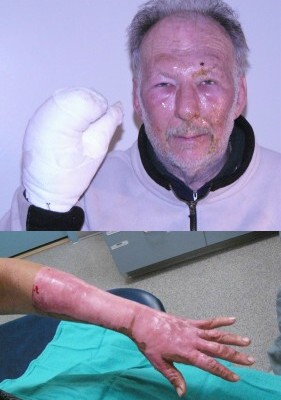
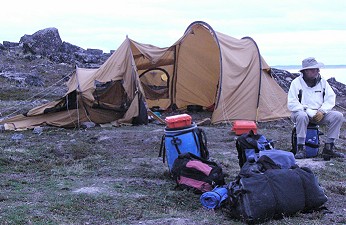
'Whoomp' is all very well, but sometimes petrol goes slightly more than whoomp. The following is true by the way: the information was obtained directly from the people concerned.
A canoe party was travelling in outback Canada and they were cooking a meal for the whole party over two petrol stoves of a very well-known brand. Unfortunately, either through too much familiarity with the stoves, or perhaps not quite enough knowledge of the hazards, they made several mistakes.
The result was that radiation, and possibly hot exhaust air too, from under the pots hit the tanks and heated them up. One tank in particular got far too hot. Yes, they did notice that the stoves were sounding rather noisy after a while, but did not realise the hazard until too late. Then as a member of the party went to check the stoves, the over-heated petrol tank exploded. Yes, one of those pumped aluminium fuel tanks we all know so well: it split opened up. Instant petrol vapour fireball.
The adjacent tent flashed of course, but you can always buy another tent. Far worse was the damage done to a couple in the party who were near the stoves. The man had his face burnt a bit and one hand severely damaged. His wife got fuel up one arm and lost the skin there. The pictures show the damage, I believe some time later, after extensive treatment.
As far as I know, they were still recovering at least a year later. Skin grafts over half an arm never look all that good, and how much of the hand will recover is still an open question. The only thing which saved them from even worse was the satellite phone the party was carrying: they were quickly choppered to a hospital.
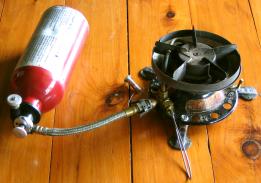
This is really just a less volatile part of the refinery output, and kero stoves are very similar to petrol ones. The fuel is not souped up with extra additives like with petrol, which is optimised for a car engine. In fact, kero is at least partly designed for lighting and for stoves. Anyhow, kero is not as volatile as Shellite, and it does not go whoomp if you throw a lighted match onto a pool of it. (Don't try this, but I have seen it demonstrated myself.) You have to heat it up to get it to vaporise before you can get a flame. Technically, it has larger or longer molecules than petrol, going up to very roughly around C14. That is, petrol consists largely of hydrocarbons with small numbers of carbon atoms per molecule, while the hydrocarbon molecules in kero are bigger. There is no real concrete borderline. If you want more details on the chemistry, see the technical Fuel Efficiency pages where it is all explained. The vaporising of the fuel is done by running the liquid kero through a preheat or generator tube which goes over the top of the burner, through the flame. Many petrol stoves have one of these as well to make them work well in cold conditions.
Brands of stoves are generally the same as for petrol, and the one to the right is a Coleman Peak 1 Apex (the name may have changed slightly since I bought it). It can burn both petrol and kero, although you are meant to change both the generator tube and the jet when swapping fuels. Several manufacturers recommend doing this changeover. The larger kero molecules require more heating to vaporise them and a smaller jet. Anyhow, kero has several definite advantages over 'petrol': it does not go whoomp and it does not have all sorts of toxic nasties in it. As a result it is a preferred choice for many people in the mountains. Also it is readily available everywhere around the world, including places like Nepal, where kero stoves and kero lamps are the order of the day.
If you are going to use kero there are few other tricks of the trade to watch. Sure, it isn't as volatile as 'petrol', but you still have to seal the container tightly. Kero can creep out of bottles under strange circumstances, and can contaminate anything surrounding it (especially food). The red nylon "Nalgene" fuel bottles sold in bushwalking shops can hold kero, but the caps will not seal well in practice. Kero is not a lubricant, and the surface of the nylon seems to go "rough" and the cap will not do up properly. Putting a fat neoprene O-ring into the sealing groove will solve this if you can find suitable O-rings. (Try the yellow pages: O-rings are readily available.) Aluminium bottles (Sigg, Laken) can also be used provided you make sure the O-ring seal is in good condition. But make sure you know which bottles contain fuel and which contain water! For that matter, the author has successfully cached kero in the Australian Alps for some time in sheltered spots in 1.25L soft drink PET bottles. They have a fair seal under the cap too.
Failure to seal a kero container can have worse consequences than a bad taste in your food. There are a couple of stories about Antarctic explorers having trouble with unsealed kero containers. One was leaving kero in cans in his caches on the outward trip, but found on the return trip that the kero had crept out of the cans despite the lids being "tight". The lack of fuel had unfortunate results for the party. Another party with this problem was Treseder and Jarvis in October 1999, who had to abort a trip after losing seven litres of fuel and the food which absorbed it. Keep your kero (and petrol) separate from your food!
For historical interest, the first 'wickless kerosene pressure stoves' were made by Primus. It was believed for a while that a Swede by the name of F.W. Lindqvist was responsible for this invention, but it now seems that the real inventor was a Dane - Frederik Ferdinand Tretow-Loof. Or so an article on the Classic Camp Stove web site says. Just thought you might be interested.
Lighting a kero stove takes more skill than lighting a petrol stove, but it isn't that difficult if you know how. There usually is a bit of a kerosene smell when starting, which can pong out a tent or hut. Basically, you need to prime the stove and preheat the generator tube. You can do this with kero, but that is unreliable and smoky, and good at blocking the jet too. A little metho works very well and is much cleaner. A good way of handling this is with a small dropper bottle: you can get some suitable Nalgene ones in good bushwalking shops, or you may find some miniature shampoo bottles in hotels. A quite small squish of metho is usually enough, although using too little can make it difficult to repeat the exercise without cooling the stove down first. Now for the magic (and essential) bit: before you light the metho make sure the generator tube is full of kero! Otherwise, when you open the valve the cold kero coming in will chill the generator tube back down so the kero doesn't vaporise and the stove won't light. Just as the metho flame runs out, gently open the kero valve and the stove should spring into life. Once you have done this a few times (practice at home!) it gets to be fairly easy. A side benefit of having the generator tube quite full before you start is that some kero leaks out when it gets warm, adding a little extra burn time to the priming process.
One or two stoves (eg the XGK and Primus Omnifuel) claim to run on these as well. The author has not tried the vodka claim but has tried both diesel and heating oil in an MSR Whisperlite and a Coleman Peak 1 Apex. These fuels were not a good idea: the very long carbon-chain molecules in them generated a fair bit of tar in the generator tube and blocked up the jets. They might work in the XGK and Omnifuel as claimed, but they do not work in most other stoves. Diesel and heating oil would make a bit of a pong too, worse than kero, and the fumes may be harmful in a confined space. I guess it made good advertising copy.
Gas stoves are a world of their own, and have their own page, which in principle follows this one. Go to it!
© Roger Caffin 1/3/2002, Roger Caffin 22/12/2005